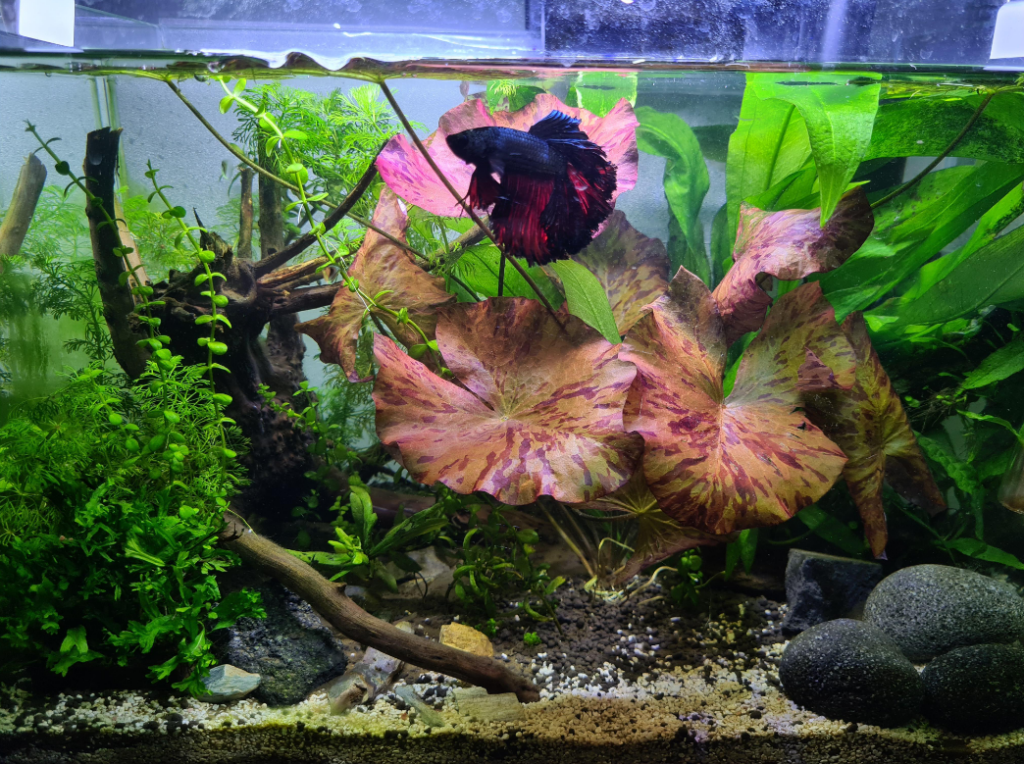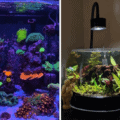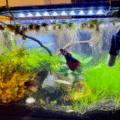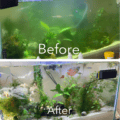Beautify your space with a hyper-realistic and immersive biotope aquarium. Learn how to replicate natural habitats in simple steps. A Biotope Aquarium is a tank containing fish and plants to look like a natural habitat for aquatic life forms. Do you know how beautiful it looks underwater when divers and snorkelers share their pictures? Now, imagine such beauty curated in a smaller tank.

That’s why biotope aquariums are all the rave amongst fish keepers. Besides the aesthetic value, creating a fish habitat replication improves the ecosystem for your pets.
There’s more to a biotope aquarium setup than just mixing plants and fish. I’ve curated some biotope aquarium planning tips to help you get the perfect combination. Check them out:
Choosing a Biotope Theme
Multiple regions inspire different biotope themes because, as you know, variety is the spice of life. We have the Amazon River, African Rift Lake, and Southeast Asian Stream, to mention a few.
Keep reading to see each habitat and learn how to select the ideal fish and plant for them.
Amazon River Biotope

Think of the heat, brown, earthy trees, and lots of greenery when choosing the decor for your Amazon River Biotope. Choosing this biotope theme means embracing the wild side because of the raw swampy look and jungle vibe it creates.
African Rift Lake Biotope

With the African Rift Lake, you’ll get almost the same vibe as the Amazon River but with slight differences.
The African Rift Lake combines the African Great Lakes from Malawi to Tanganyika: Lake Victoria, Lake Edward, and Lake Albert. Its waters are very clear, and you can see its rocky beds through its great depth.

Choosing the African Rift Lake Biotope is ideal for creating an airy aura in your lobby or interior room.
Southeast Asian Stream Biotope

Floral enthusiasts will love the Southeast Asian Stream Biotope because of its rich plant fauna and elegant, streamlined fish. If you’re curating a biotope aquarium strictly for its aesthetic value, this is your theme!
Now that you’re clear on the aquarium theme selection, let’s discuss choosing the occupants of your artificial habitat.
Selecting Fish, Plants, and Invertebrates
Remember that designing a biotope aquarium is about simulating the natural habitat of your desired fish. So, only choose native plants, fish, and compatible invertebrates that live in the same water region.
Studying fish compatibility with the other living organisms in the habitat will improve their lifespan because you’ll be less prone to making fatal mistakes.
The aquarium ecosystem is as important as the open waters because the wrong mix may cause contamination, diseases, or death of your fish and organisms.
Sticking to a biotope theme is the easiest way to select fish, plants, and invertebrates without hazard. Once that’s sorted, setting up your biotope aquarium is next.
Setting Up The Aquarium: Equipment and Materials
We’ll start by making a checklist of these basic aquarium equipment and materials:
- Aquarium Tank
- Filtration System
- Test Kits
- Heaters or Conditioners
- Substrate
- Softscaping Decor
- Lighting
- Aquarium Toolkit
- Fish
- Plant
- Invertebrates
Note that these equipment helps you mimic the natural conditions of your biotope theme. They’re not just random tools you can swap with alternatives in case of unavailability. So, do your best to get the exact ones. Now, let’s dive deep into their uses.
- Aquarium Tank: The tank setup is a no-brainer because you need a house for your mini habitat. Choose the size based on the fish species and amount. Big fish need large tanks for unrestricted movement.
- Filtration System: You can choose any biological, chemical, or mechanical filtration system for your biotope aquarium. They’re necessary to clean the aquarium water by sifting dirt and debris. Here’s a list of the most quiet aquarium filtration systems.
- Test Kits: You must test the water before, after, and during aquarium use. You must always maintain the ideal habitat quality, including the ammonia, nitrate, nitrite, and pH levels.
- Heaters or Conditioners: These depend on the biotope theme you’ve chosen. Some habitats require warm water, while others need cool environments for aquatic life to thrive. For example, use a heater for an Amazon River biotope.
- Substrate: Your Substrate selection depends on your biotope theme. A substrate is your aquarium bed, so it can be sand, gravel, customized seabed, or even artificial forest floors.
- Softscaping Decor: This differs from your substrate because it’s the material you layer over. Use natural decor native to your biotope, such as plants, rocks, or driftwood. Remember, your invertebrates and fish must feel at home with this decor.
- Lighting: Because your live plants and fish will be in confined tanks, aquarium lighting must be adequate for both organisms. It shouldn’t be so bright that it kills the flora or blinds the fish, and it shouldn’t be so dim that your fish will struggle with movement. Here’s a list of the best aquarium lighting units.
- Aquarium Tool Kit: Use the appropriate equipment and tool kit to set up all the fixtures and fittings on your biotope. Get scissors and tweezers to groom the plants and scrapers to clear algae.
Now that you have the tools, I’ll show you how to decorate the ideal habitat.
Creating the Ideal Habitat: Layout and Decoration
I recommend getting pictures of your preferred habitat so you can choose the right tools and decor for the biotope design replica. If you dive in headfirst without proper planning, you’ll make several mistakes that will cost you a lot of money to reverse.
So, let’s be cautious.
Draw your aquarium layout on paper or digitally before turning the designs into reality. Then, pay attention to the substrates, plant arrangements, and softscaping decor for your habitat decoration. Which artificial pieces or natural decor best represents each element from your biotope?
You have many options to select from, including gravel, pebbles, driftwood, and other appropriate elements. After all, the point of having a biotope aquarium is to create a realistic environment!
Water Parameters and Maintenance

Earlier, you saw the need for heaters or water conditioners to control temperature in your aquarium. Here’s more information on that:
You must first research your specific biotope to know the ideal water condition for your fish and plant. Using the three examples in this guide, here’s an example of perfect water temperatures for each biotope –
| Water Parameters | Amazon River Biotope | African Rift Lake Biotope | Southeast Asian Stream Biotope |
| Temperature Control | 24°C-28°C | 75°F – 82°F | 24°C-28°C | 75°F – 82°F | 24°C-28°C | 75°F – 82°F |
| pH Levels | 6 – 7.5 | 7.8 – 8.6 | 6 – 7.5 |
| Hardness | Soft to Moderately Hard | Very Hard | Soft to Moderately Hard |
Regular testing will alert you when it’s time for aquarium maintenance and adjustment of your water parameters. Now, let’s get to the exciting part!
Introducing Fish and Plants to the Aquarium
The introduction of fish in your curated biotope aquarium is an art. You can’t just drop every species into the water and expect perfection. No! Instead, you need an aquarium acclimation process to ensure your floral and fauna are compatible.
And no, it’s not a complicated process to follow. Start with plant acclimation like this:
- Treat your new plants to ensure they’re disease—and pest-free. When rooting the plants, trim excess leaves and rinse off dirt before adding them to your tank.
- Fill a vase with the same water in your biotope aquarium. Then, add your plants to the vase. This helps the plant acclimate to the artificial environment before introducing it to the larger tank.
- Gently root the plants into the aquarium’s substrate and arrange the softscape decor around its base.
All I’ll say about this is that fish and plant care requires dedication, but it’ll become a breeze once you get a hang of it.
Long-Term Care and Monitoring
If you plan to own an aquarium for as long as your fish lives (typically six to 20 years or more), prioritize long-term care.
It’s mostly about fish behavior observation and their interaction with the plants, substrates, invertebrates, and other organisms in the habitat. You’ve already learned about the water quality maintenance of a biotope aquarium and how it must match real-life water bodies.
If you notice any oddities during your routine aquarium monitoring, don’t hesitate to make the necessary environmental adjustments. Always ensure the habitat is healthy for a thriving flora and fauna cohabitation.
Common Challenges and Solutions
No matter how hard you try, here are some common challenges you’ll face while caring for your biotope aquarium:
Biotope Challenges
- Excess Algae: Algae control is one of the biggest challenges aquarium owners face because Algae thrive in water.
- Fish Disease: New fish or plants may be incompatible with each other to the point where they’ll become harmful. In worse cases, when untreated, these new flora and fauna cause diseases in existing organisms in the aquarium.
- Water Parameter Fluctuations: Although I’ve shown you the ideal water parameters for sample biotope themes, they are not guaranteed to be an exact match with the real lake, spring, stream, or river.
Don’t worry too much. I have solutions handy for you!
Biotope Maintenance Solutions
- Aquarium Troubleshooting: To prevent Algae growth, ensure you don’t overfeed your fish so there’s no excess food to encourage the weed. Add lighting to your biotope to kill the algae without harming your substrate. Also, trim your plants periodically so there’s no overgrowth.
- Fish Disease Prevention: Treat new plants before adding them to the aquarium. When planning to add a new fish into the habitat, research and ensure it’s compatible with the biotope.
- Water Parameter Stability: The best way to get a 99.99% match is to adjust the water parameters. Check the pH levels, hardiness, alkaline level, and temperature. Then, stabilizers like heaters or water conditioners regulate the temperature.
Benefits of Biotope Aquariums

Don’t let the maintenance requirements discourage you from building your artificial habitat. There are many benefits to having a biotope aquarium. Check them out.
Aesthetic Appeal
Perhaps this is the number one reason anyone would get a biotope aquarium! An accurately designed biotope is a stunning sight, just like the beauty of the natural habitat.
Unlike plain aquariums, which only show the fish, this one creates an immersive experience because you can watch your pets interact in their natural element.
Educational Value
Creating a biotope aquarium is the best solution if you must research the behavior, conservation, and other details of aquatic life but can’t afford to travel to a specific destination. You can build the ecosystem and study the interaction of all organisms within it!
So, creating a biotope aquarium benefits both personal and professional users.
Natural Fish Behavior
Keeping fish away from their natural habitat puts them at risk of behavioral changes and possibly poor health development. But with a biotope aquarium, you will encourage natural fish behavior because the pets won’t feel out of place.
Instead, it’ll be like they’re in a smaller version of their real-life habitats. This will ensure you get the best possible version of your fish as they forage, feed, and interact with other living organisms in the habitat.
Aquarium Enjoyment
Besides displaying the fish for aesthetics, you can also indulge in aquarium enjoyment. You should view your aquarium maintenance and care as a hobby, not a chore, to truly enjoy the experience.
Have fun while setting up your biotope, and take time out of your schedule to observe the beauty of fish interacting in their natural habitat. You may learn a thing or two!
Let’s explore why choosing the correct aquarium heater size matters in this informative guide.
What is the Easiest Biotope To Start With?

Are you already sold on getting a biotope aquarium but don’t know where to start? I recommend building a Southeast Asian stream or Amazon River replica for your beginner biotope since they don’t need too many sophisticated resources for setup.
The Southeast Asian stream biotope replicates popular streams from Indonesia, Malaysia, and Thailand. You need an average flow of soft to moderately hard water with a slightly acidic pH. See the water parameters above.
The basic organisms are Gouramis and Rasboras fish living with Java ferns and Anubias.
You can also try the Amazon River biotope, which originates in South America. It has the same water parameters as the Southeast Asian stream biotope but different organisms.
For this biotope aquarium, get Dwarf Cichlids and Tetras fish, along with Vallisneria and Amazon sword plants. Build your substrate with driftwood for that natural blackwater look, making it look like you’re deep in a Brazilian rainforest.
Relatively, one of these two is the easiest biotope to replicate.
How Do I Maintain Water Quality in a Biotope Aquarium?
I can’t overemphasize the importance of water parameter testing for the best biotope aquarium. Do this periodically, at least weekly, to quickly note aquarium water changes that can harm your fish and plants.
Get a filtration system to keep the water clean and free from contamination. You need dedicated water quality maintenance if you want a healthy and stable environment for your biotope organisms.
Can I Mix Fish from Different Biotopes?
Yes, you can. But I must warn you that mixing fish from different biotopes in one aquarium is risky. When doing this, consider the water parameters, behavioral, physical, and biotope compatibility, dietary needs, and health effects.
Some fish are stronger and faster than others, which would breed unhealthy competition in the ecosystem when mixed. So, your priority should be creating aquarium balance over diversity.
Conclusion
I’ve enjoyed sharing our ideas on creating a biotope aquarium with you and hope you loved learning about it, too. Here’s a quick recap before leaving you to start your aquarium journey:
- Choose a biotope theme.
- Selecting native fish, plants, and invertebrates gives you natural habitat rewards.
- Map out your layout and design before getting started.
- Use ideal equipment to set up.
- Create a balanced ecosystem.
Remember that setting up a Biotope Aquarium is an ongoing learning process, and there is no singular way. Be open to change, and don’t neglect your fish’s care and maintenance.













4 thoughts on “Setting Up a Biotope Aquarium: Replicating Natural Habitats ”